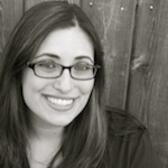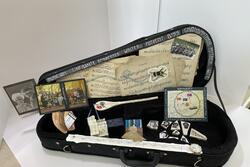The Top 10 Jewish Women in Labor History
Though we at JWA celebrate women’s history all year round, March brings us the great opportunity of Women’s History Month. This year, March also brings the 100th anniversary of the Triangle Shirtwaist Factory fire. JWA will mark the day with a luncheon and walking tour; a whole slew of other commemorative events will be happening throughout the month. Given the centennial of this major event in labor history, as well as the current situation in Wisconsin, there has never been a better time to focus on labor organizing and the pivotal role Jewish women have played in its history. That's why we are sharing our Top 10 list of Jewish women in American labor history in a 10 part series for Women's History Month.
This list is by no means exhaustive, comprehensive, or broad in scope. By its nature, it's limited to 10 people. In choosing the women, we focused on people connected to the Triangle fire or those who were active in the same general time period. A few of the names you might recognize, but the majority are largely unknown. Each day for the first two weeks of March, we will post the "10 Things You Should Know" about one of these women. By the middle of the month, you will be an expert on the lives and work of these trailblazing Jewish activists.
Click each woman's name for a list of the "10 things you should know" about her.
-
Rose Pesotta: Born in 1896 in the Pale of Settlement to a hard working mother and a “dynamic and unconventional” father, who passed on his revolutionary leftist politics, Rose Pesotta grew up to be a committed anarchist and labor reformer. After immigrating to the United States in 1913, Rose she got a job as a shirtwaist maker and immediately joined the International Ladies’ Garment Workers’ Union. She quickly rose in the organization’s ranks, eventually becoming one of its first female vice presidents.
-
Rose Schneiderman: Less than five feet tall and with a head full of flaming red hair, Rose Schneiderman was nicknamed the “Red Rose of Anarchy.” An immigrant from Russia, she was a garment worker who became a labor leader, serving as president of the New York Women’s Trade Union League from 1917 to 1949. Friend and advisor to the Roosevelts, she was also an advocate for Jewish refugees from Europe and a dedicated labor Zionist.
-
Bessie Abramowitz Hillman: One of ten children, Bessie Abramowitz was 15 years old when she emigrated from Russia to Chicago in 1905 to avoid a marriage arranged by the local Jewish matchmaker. During her long career with the Amalgamated Clothing Workers of America, Bessie Abramowitz Hillman worked tirelessly to promote labor reform.
-
Clara Lemlich: Inspired from a young age by the writings of Russia’s revolutionaries, Clara Lemlich went on to become a union activist, communist, and suffragist. She was in her early 20s when she gave an impassioned speech in Yiddish at a mass meeting of shirtwaist workers in November 1909; the result was the “Uprising of 20,000,” the first major strike by women in the garment industry.
-
Belle Moskowitz: Though she would eventually become one of the most powerful and influential women in the Democratic Party, Belle Moskowitz began her career working at the Educational Alliance settlement house and writing for social reform journals. Born in Harlem in 1877, she later became a close advisor to New York Governor Al Smith and helped him with four successful gubernatorial races and one unsuccessful bid for the presidency.
-
Pauline Newman: The first woman ever appointed a general organizer of the International Ladies’ Garment Workers’ Union, Pauline Newman dedicated her life to the betterment of the American worker. Remembered as a woman “capable of smoking a cigar with the best of them,” Newman was also a leader in the socialist and suffrage movements and a prolific writer who chronicled the experience of being an immigrant working woman.
-
Emma Lazarus: Though not known as a labor activist but rather for her poetry, Lazarus worked as an advocate on behalf of Eastern European Jewish immigrants and wrote the words that came to represent their plight. “Give me your tired, your poor,/ Your huddled masses yearning to breathe free.” These words, part of “The New Colossus,” the poem inscribed at the base of the Statue of Liberty, were written by Emma Lazarus in 1883. The daughter of a prominent Sephardic Jewish family in New York, Emma was considered a gifted literary critic and poet as well as a passionate spokesperson for the most needy of the Jewish community.
-
Lillian Wald: Born into a well-to-do German Jewish family in Cincinnati and raised in Rochester, NY, Lillian Wald is credited with founding the profession of public health nursing. A champion of health care for immigrants, she founded the Henry Street Settlement House in New York in 1895 and headed it until 1933.
-
Fannia Cohn: Born to a family of wealthy Russian Jews in 1885, Fannia Cohn immigrated to New York City in 1904. She would become one of the leading women trade unionists in the United States. The first woman to serve as vice president of the International Women’s Garment Workers’ Union, she led the way in establishing workers’ educational programs across the country.
-
Gertrude Weil: Born in North Carolina in 1879, Gertrude Weil was a southern Jewish activist, a passionate campaigner for women’s suffrage and labor reform. Although many other southern Jews of her generation feared to take an active stance lest they trigger antisemitism, she believed that women could make the greatest difference in society through active involvement in politics.
So stay tuned for more on each of these women, and look forward to the second half of March when we will share our list of the Top 10 landmarks in the Triangle Factory fire story (with an online walking tour recently featured on PBS's American Experience website!)
Happy Women's History Month!








My mother was born in NYC in 1901. and lived in eastside mid manhattan. She has told me about a Jewish woman lawyer? who was a socialist or at any rate on the political left that used to give speeches from the back of a truck, then lead the crowd into the song: Azoy, azoy, a schicker is a goy." She is supposed to have had only one arm, the other one lost when she fell from a window and caught it on a garbage can. Can anyone tell me her name? I am writing a family biography and would like to know. This would have been anytime from say 1908 to 1918. Thank You, Lawrence Kallus fiddler law@gmail.com.